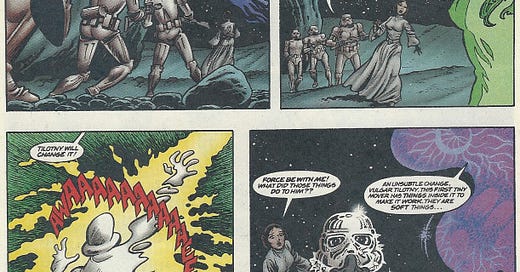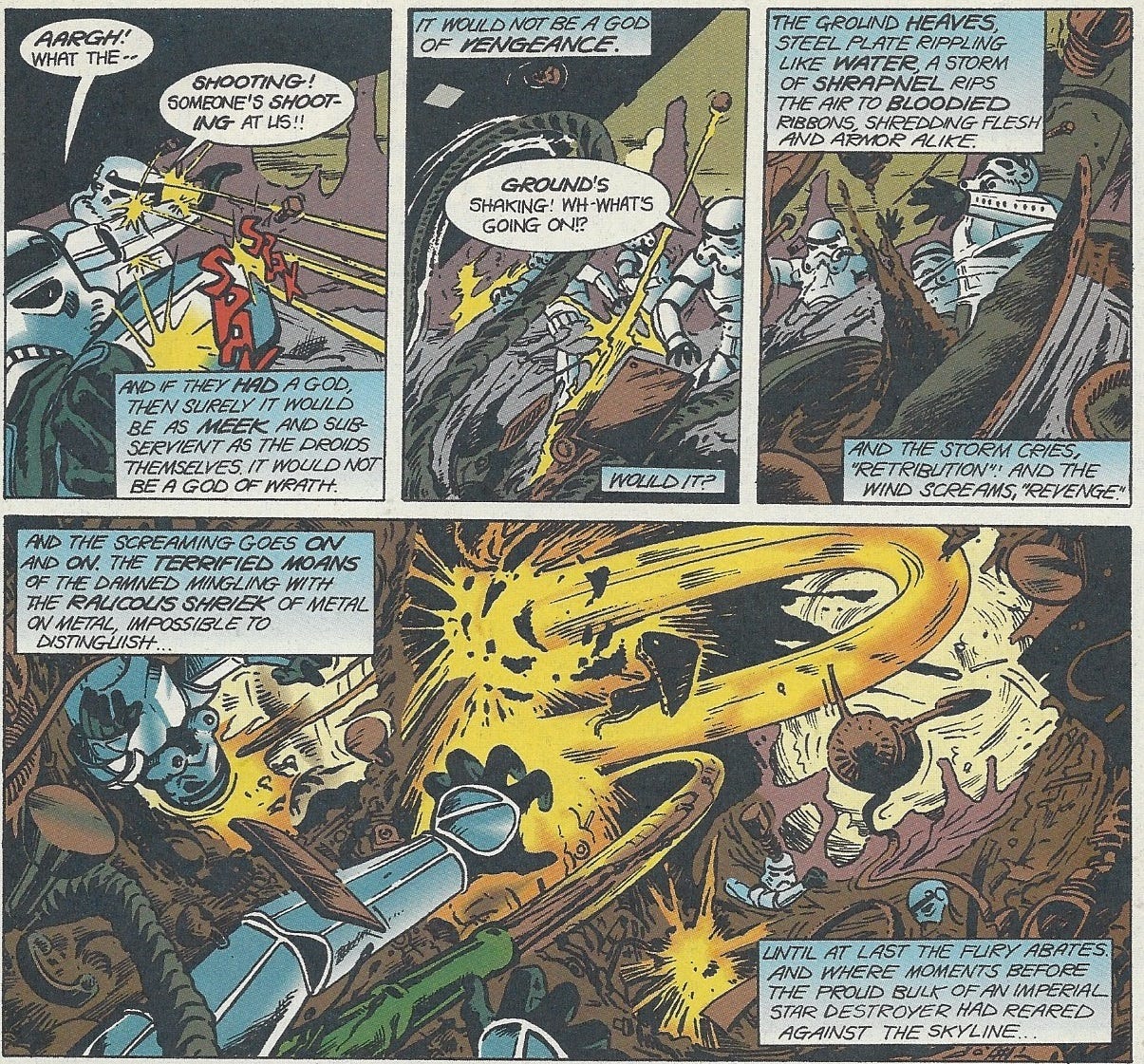What stories can Star Wars tell? – Alan Moore’s Devilworlds
Alan Moore's bizarre, largely forgotten Star Wars comics show the versatility of the Galaxy Far, Far Away.
“If you watch a ‘Star Wars,’ you’re pretty much going to get the same version of ‘Star Wars’ each time,” Mark Ruffalo asserted recently while defending the Marvel Cinematic Universe.
He may have a point, though I don’t think it does much to absolve the MCU. The formula of George Lucas’ Star Wars films was obvious enough that people tried to craft high-minded theories around it. I wouldn’t say that’s improved under Disney.
For all its bold choices, even highly contentious The Last Jedi dribbles into a distinctly Star Wars shaped mold by the time the credits rolled.
But does that justify Marvel’s film slate practically blurring together or any of the other issues? I’d say no.
Especially because Star Wars has proven to be a surprisingly flexible setting in its vast ocean of tie-in media. The Lucas produced Clone Wars TV show branched out in plenty of directions with episodes centered on brain worm zombies and Kaiju-esque aliens.
As often as they’d settle for emulating the films, even the books and comics would delve into places the films wouldn’t and perhaps couldn’t go. Coruscant Nights, MedStar Duology, and Death Troopers all experimented with different genres in the Star Wars universe.
None of these books were exceptional but they still pushed the boundaries of the setting without breaking them.
The real proof that Star Wars can be more than just the same three films endlessly repackaged is Alan Moore’s little-known contributions to the franchise. Before he wrote medium changing works like Swamp Thing, V for Vendetta, or Watchmen, he contributed a handful of short comics published in the Marvel Star Wars UK magazine in 1982.
These five stories were republished along with two tonally similar Marvel UK comics in the two-issue miniseries Devilworlds in 1996 by Dark Horse.
Featuring the film heroes, the comics present a different kind of Star Wars, a hostile galaxy with ancient powers beyond comprehension. There’s a Lovecraftian tone to Devilworlds, with the heroes left at the mercy of these strange beings and their understanding of reality itself questioned.
One common theme with these stories is the explicitly supernatural bent. “Space wizards” is a term thrown around by certain fans these days but the Jedi and even their underpinning belief system ends up looking downright mundane in Devilworlds.
The Empire’s doubt in the supernatural is lambasted in “Rust Never Sleeps,” where R2-D2 and C-3P0’s diplomatic mission to a junkyard world reveals a planet sized mechanical god,
And that droid god ends up being the least mysterious force, with an exposition for its origin and a relatively simple concept. The first and perhaps strongest story, “Dark Lords Conscience,” has Darth Vader lure out Clat the Shamer, a mystic-assassin capable of inducing suicidal levels of guilt for misdeeds real or imagined.
An interesting implication in Devilworlds is that for all its fantasy trappings, the less magical Star Wars galaxy we know is due to suppression. The Empire’s agenda is explicit but even the Jedi are implicated in “Blind Fury,” as Luke stumbles upon the site of an ancient battle between the warrior-monks and one of their rivals, the soul-snatching Order of the Terrible Glare.
With this story, Moore presents another ancient order with unnatural abilities, who are also wiped out—but this time the Jedi are responsible. Luke recalls that his predecessors went as far as “[laying] waste” to their homeworld. It casts the Jedi’s own fate in a different light.
Implications aside, those Devilworlds stories can be chalked up as being imaginative takes in a setting that only had two movies to its name at that point. The last two stories go so beyond the pale that they strain against any version of the setting, no matter how early and unexplored.
In “The Pandora Effect,” Han Solo’s usual smuggler antics ends with them tortured by an order of immortal humans worshipping an enigmatic, vaguely satanic god of evil. One of their fellow prisoners is even stranger, casting doubt on the light and dark dichotomy of the Force presented in the films.
“Tilotny Throws the Shape” is the final story and would be more than at home in Moore’s other works, like Miracleman. Leia and a group of pursuing stormtroopers encounter several abstract god-like beings, curious about the linearity of their new playthings with painful, cosmic results. Leia, after surviving through pure luck and circumstance, notes “Stranger things have happened in space… although I can’t think of any…”
Clone Wars would end up having its own god-like beings with the Mortis arc. But they conformed neatly to the viewers’ understanding of the Force, their prophecies and plans tying directly to the events of the films. Even if their powers were beyond what had appeared previously on-screen, they remained in line with what we had seen.
Not so for Devilworlds, as though tied to the Force, its own gods are hostile and largely incomprehensible.
Beyond the strange concepts, throughout Devilworlds Moore removes the heroes’ agency. Luke, Leia, and Han’s encounters with these beings are entirely accidental. Only Vader maintains his stolid, fearsome aura and gets to directly dispatch his unnatural adversary. Meanwhile the heroes must trust an outside power or simply ride out the whirlwind of supernatural events.
Though Luke Skywalker, Han Solo, and Princess Leia weren’t totally beatified in Western mass media by this point, it’s strange to see them treated with such disregard by an official piece of media. Devilworlds forcefully suggests these characters and their interplanetary struggle aren’t that special – but then what could be “special” in a galaxy this big?
More interesting is how Moore subtly and less than subtly questions the heroes’ morality. “Rust Never Sleeps” might be the first piece of Star Wars media to confront how morally repugnant it is to treat sentient beings as literal appliances. While Solo broaches that topic, it ends up reducing the issue to the ravings of an eccentric droid, the butt of the joke.
The narration in “Blind Fury” casts Luke as a bumbling boy hero, defeating the High Shaman of the Terrible Glare in a factual and polite way. The last two panels suggest there’s a lesson to be learned from this experience and then slyly hints that Luke is unlikely to take it to heart.
While framed as one of Han’s sly jokes, after releasing an amoral, god-like being on their captors and the wider galaxy in “The Pandora Effect,” Han comforts the group by noting that at least they released it in an Imperial sector.
Devilworlds would languish in questionable canonicity decades after publication. An article shedding light on these beings was scrapped before it could run in the short-lived Star Wars Gamer magazine.
Published online, that was later spun into an unofficially released novella pitched for the defunct Hyperspace.com, titled Supernatural Encounters: The Trial and Transformation of Arhul Hextrophon.
I haven’t look too closely at that admittedly valiant effort, in part because I think Devilworlds works because of its sense of mystery. These stories show fragments of impossibly large ideas and that makes the subjects grotesque and intimidating.
The less we know, the better.
For all its strangeness, Devilworlds is still distinctly Star Wars – maybe more to the idea of an ancient, fantastic galaxy than most depictions of it. Beyond proving the versatility of the setting, I hope that someday Star Wars media finds its way back to the hostile, unknown realm of Shamers and Shapers.









Great piece, Matt! Was not aware of these at all. :D
Mark Ruffalo clearly hasn't seen the Christmas Special - that broke the mold! Just kidding. Good review, 'The Pandora Effect' sounds like a great story.